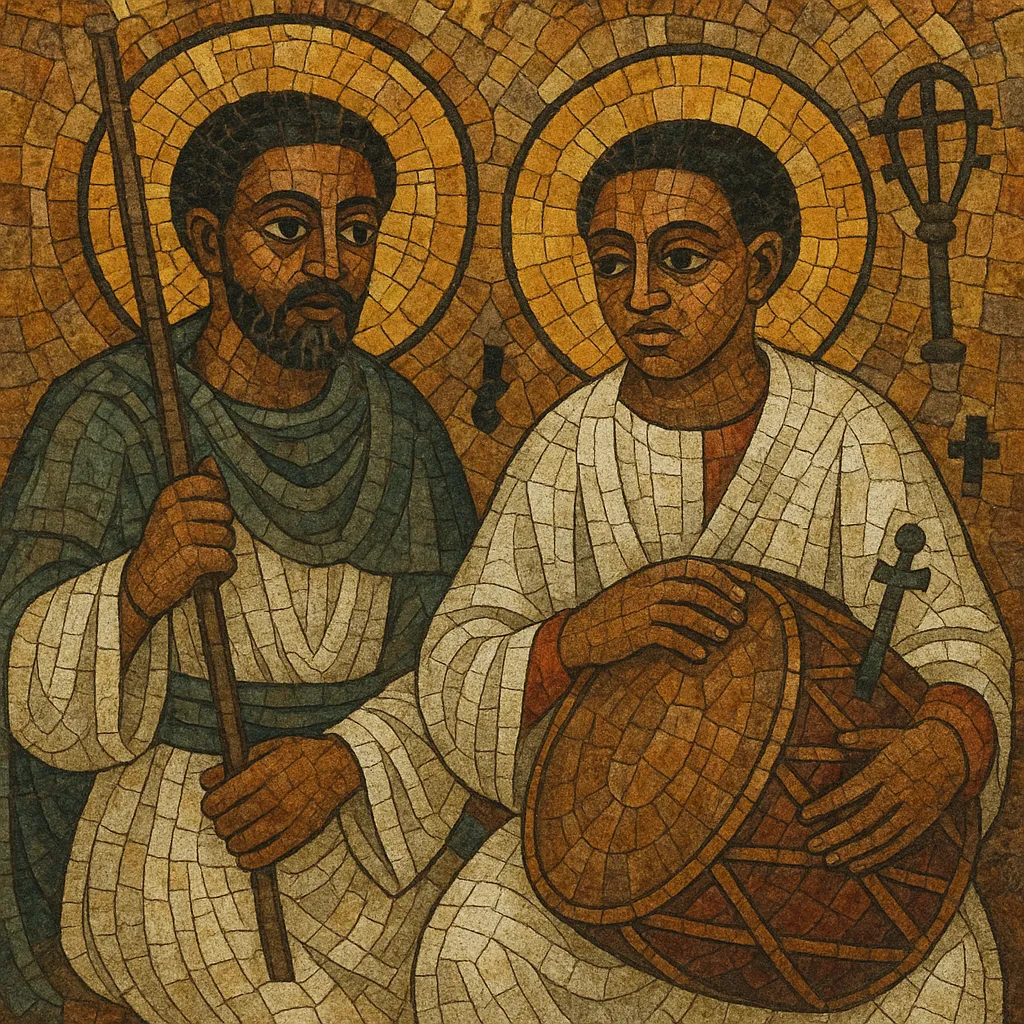Zema is the sacred chant tradition of the Ethiopian Orthodox Tewahedo Church, attributed to Saint Yared in the 6th century. In Ge'ez, “zema” means “melody/chant,” and the term encompasses a complete liturgical music system of modes, repertories, and performance practice.
The tradition is sung in Ge'ez (the ancient liturgical language of Ethiopia) and is performed by trained cantor-priests (debtera) and choir schools. It features ornate, melismatic vocal lines; responsorial/antiphonal textures; and ritual movement known as aqwaqwam, accompanied by kebero drums, the tsenatsil (sistrum), and the rhythmic tapping of the mequamia (prayer staff). Zema is transmitted primarily through oral pedagogy supported by neumatic cue-signs (melekket), and its core modal family is often summarized as Ge'ez, Izil, and Araray.
According to Ethiopian ecclesiastical tradition, Zema was codified by Saint Yared (c. 505–571) in Aksum. Yared organized the chant into structured liturgical books (such as the Deggwa) and repertories for the annual cycle of feasts. He also articulated the core modal ethos commonly summarized as Ge'ez, Izil, and Araray.
For centuries, Zema has been preserved in church schools and monasteries through intensive apprenticeship with master chanters (liqā). Instruction blends oral transmission with a system of mnemonic neumes (melekket) that indicate melodic and rhythmic cues rather than exact pitches. Performance practice integrates aqwaqwam (sacred dance steps), the mequamia (staff) for coordinated movement, kebero drums for pulse cycles, and tsenatsil (sistrum) for shimmering rhythmic emphasis.
Zema underpins the full Ethiopian Orthodox liturgy (Qeddase), the Hours, processions, and major feast days. It employs responsorial exchanges between a soloist and a chorus, elaborate melismas on sacred texts in Ge'ez, and carefully timed ritual actions. Distinct chant families are used for penitential, festal, or ordinary seasons, giving the calendar a rich musical topology.
Despite modern urbanization and recording, Zema remains a living, primarily oral tradition anchored in monasteries, cathedral choirs, and parish schools across Ethiopia and the diaspora. Archival efforts and choral recordings have broadened access, while local chant schools continue to train new generations, ensuring stylistic continuity from its 6th‑century origins to the present.
Select a liturgical text in Ge'ez appropriate to the service (e.g., Qeddase, Hours, or feast-day procession). Determine whether the piece is penitential, ordinary, or festal, as this governs melodic contour and tempo.
Anchor the melody in one of the core modal families: Ge'ez (solemn/central), Izil (penitential/weighty), or Araray (lighter/joyous). Maintain a narrow-to-moderate ambitus and favor stepwise motion with expressive melismas on key theological words.
Use responsorial or antiphonal textures: a soloist intones the lead line, and the chorus answers or sustains refrains. Ornament the line with melismas while keeping syllabic clarity for doctrinal phrases. Employ heterophonic thickness by allowing small variations between voices.
Mark the pulse with kebero drums in cyclical patterns appropriate to the season, add tsenatsil (sistrum) strokes for shimmer and timing, and coordinate aqwaqwam steps using the mequamia staff. Keep tempos dignified, with slight accelerations only on processional or festal refrains.
Sketch melekket (neumatic) cues to guide performance practice, but rely on memorization and rehearsal with a master chanter for phrasing, cadence formulas, and seasonal variants. Prioritize diction in Ge'ez and ensemble unity over fixed-score precision.


